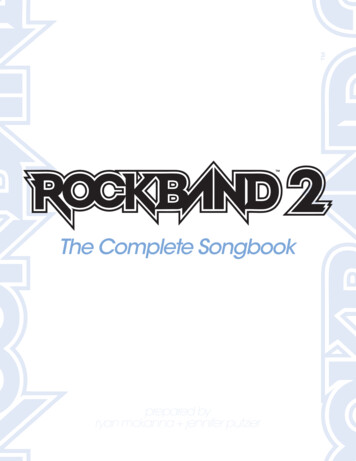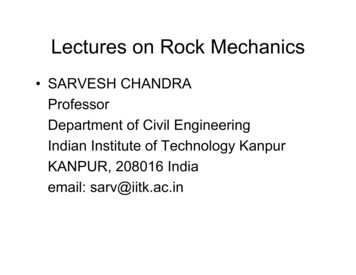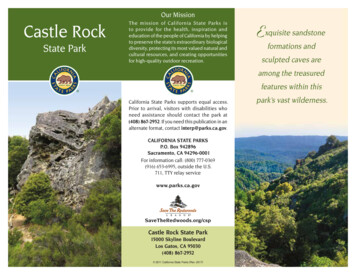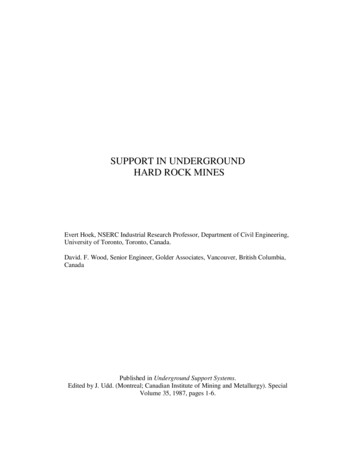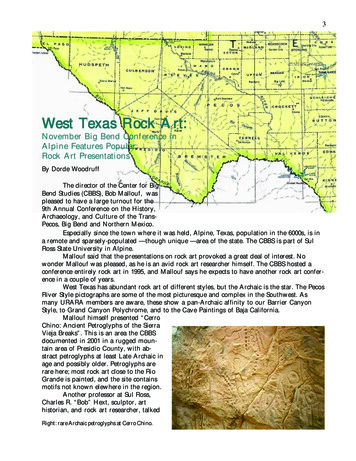
Transcription
Earth Surf. Dynam., 9, 665–672, 2021https://doi.org/10.5194/esurf-9-665-2021 Author(s) 2021. This work is distributed underthe Creative Commons Attribution 4.0 License.Short communication: Runout of rock avalanches limitedby basal friction but controlled by fragmentationØystein T. Haug1,2 , Matthias Rosenau1 , Michael Rudolf1 , Karen Leever1,3 , and Onno Oncken11 GFZGerman Research Centre for Geosciences, Helmholtz Centre Potsdam,Telegrafenberg, 14473 Potsdam, Germany2 Njord centre, Department of Geosciences, University of Oslo, P.O. Box 1048, 0316 Oslo, Norway3 Van Hall Larenstein University of Applied Sciences, Larensteinselaan 26a, 6882 Velp, the NetherlandsCorrespondence: Matthias Rosenau (rosen@gfz-potsdam.de)Received: 21 September 2020 – Discussion started: 30 October 2020Revised: 25 March 2021 – Accepted: 18 May 2021 – Published: 23 June 2021Abstract. Rock avalanches produce exceptionally long run-outs that correlate with their rock volume. Thisrelationship has been attributed to the size-dependent dynamic lowering of the effective basal friction. However,it has also been observed that run-outs of rock avalanches with similar volumes can span several orders ofmagnitude, suggesting additional controlling factors. Here, we analyse analogue models of rock avalanches,with the experiments designed to test the role of dynamic fragmentation. We show that for a fixed low basalfriction, the run-out of experimental rock avalanches varies over 2 orders of magnitude and is determined bytheir degree of fragmentation, while the basal friction acts only as an upper limit on run-out. We interpret therun-out’s dependence on fragmentation as being controlled by the competition between mobility enhancingspreading and energy-consuming fragmentation limited by basal friction. We formalize this competition into ascaling law based on energy conservation, which shows that the variation in the degree of fragmentation cancontribute to the large variation in run-out of rock avalanches seen in nature.1IntroductionWith volumes larger than 109 m3 and speeds reported atover 150 km/h (Campbell, 1989) and possibly up to 100 m/s(Legros, 2002), the destructive power of rock avalanches isunprecedented. They are exceptional hazards produced whenvery large rockslides disintegrate during transport (Hungret al., 2013). The travel distance of the deposit front, or runout, is an important measure for hazard assessment (Vaunatand Leroueil, 2002) and is generally found to be more than 10times longer than the fall height (Hsü, 1975). This suggestslow effective basal friction µeff , which is usually attributedto various dynamic weakening processes (e.g. Kent, 1966;Shreve, 1968; Hsü, 1975; Melosh, 1979; Campbell, 1989;Pudasaini and Miller, 2013; Legros, 2002; Lucas et al., 2014;Wang et al., 2017) or additional basal erosion processes (e.g.Hungr and Evans, 2004; Pudasaini and Fischer, 2020).Field observations of the displacement of rock avalanchesare typically given by the ratio of vertical (H ) and horizontal(L) distance from the deposit’s front to the top of the mainscarp. The resulting ratioµapparent H,L(1)is known as the Heim’s ratio (Heim, 1882, as cited in Hsü,1975) and serves as a proxy for µeff , where it is calledthe “apparent” coefficient of friction (Manzella and Labiouse, 2012). One of the best established but perhaps leastunderstood observations of rock avalanches is the dependence of the Heim’s ratio on volume: rockslides below asize of approximately 106 m3 all have a relatively constantHeim’s ratio of 0.4–0.7, but for larger rockslides Heim’sratio decreases with volume, reaching values 0.1 for volumes larger than 109 m3 (Pudasaini and Miller, 2013; Lucas et al., 2014). This suggests a scale-dependent mechanismof decreasing apparent friction with volume that becomesPublished by Copernicus Publications on behalf of the European Geosciences Union.
666dominant at large volumes (Davies and McSaveney, 1999).Analytical modelling and numerical simulation involving lubrication mechanisms by Pudasaini and Miller (2013) andLucas et al. (2014) provided mechanical explanations forthis observation. Importantly, however, even within a narrowrange of volumes, run-outs are seen to span orders of magnitude, suggesting additional controlling factors on run-outthat are insensitive to size. Runout variability also lies in partin the fact that the run-out is defined by the front of the deposits, and it therefore contains the combined effect of bothtranslation and spreading of the rock mass. The additionaltravel distance caused by spreading can have a profound effect on the run-out (Staron and Lajeunesse, 2009), especiallyif the effective basal friction is low.Recently, the process of dynamic fragmentation has received increased attention from the research community, andmuch progress has been made in our understanding of itsrole in the dynamics of rock avalanches (Locat et al., 2006;Imre et al., 2010; Bowman et al., 2012; Pudasaini and Miller,2013; De Blasio and Crosta, 2015; Haug et al., 2016; Zhaoet al., 2017, 2018; Lin et al., 2020; Gao et al., 2020; Knappand Krautblatter, 2020). Firstly, one may expect that the finerthe material is, the more flow-like the behaviour will be, increasing its mobility and allowing the rock mass to spreadmore easily (Locat et al., 2006; Wang et al., 2017; Zhao et al.,2018). Secondly, models of fragmenting rockslides suggestthat dynamic fragmentation actively increases the spreading(Bowman et al., 2012; De Blasio and Crosta, 2015; Lin et al.,2020). However, fragmentation has also been shown to consume energy (Haug et al., 2016; Zhao et al., 2017; Lin et al.,2020), potentially at a cost to the run-out length. Clearly, understanding the integrated effect of fragmentation on the runout dynamics of rock avalanches requires more analysis.To study the effects of friction and fragmentation on rockavalanche dynamics, here we analyse analogue models of dynamically fragmenting rockslides. We assume that there exists some mechanism (or a set of mechanisms) that causes alow effective coefficient of basal friction, which we set to0.15–0.20 in our models. To isolate the scale-independenteffect of fragmentation we keep both the volume and friction within a narrow range in our models compared to nature. Note that this approach explicitly excludes dynamicweakening mechanisms that are suspected in natural prototypes. Specifically, our models do not include fluids, andfrictional heating is insignificant such that lubrication mechanisms (e.g. Pudasaini and Miller, 2013; Lucas et al., 2014)do not play a role. Granular pressurization (e.g. Imre et al.,2010) is also not considered significant in our experimentsbecause of the low energy involved. Other potentially important mechanisms like bedrock erosion (e.g. Hungr andEvans, 2004; Pudasaini and Fischer, 2020) are excluded herefor simplicity. The experimental design therefore means thatthe observed variation in Heim’s ratio is due to fragmentation and dry friction. We describe the dependence observedbetween the run-out and the degree of fragmentation in theEarth Surf. Dynam., 9, 665–672, 2021Ø. T. Haug et al.: Runout of rock avalanchesFigure 1. Sketch of the slope geometry of experiments, relevant pa-rameters, and length scales (modified following Haug et al., 2016).form of a scaling law. Finally, we compare our experimental results to a set of natural data and discuss their relevanceto natural systems. All data underlying this study and additional relevant data are published as open access in Hauget al. (2021).2Experimental methodsIn the experiments originally documented in Haug et al.(2016), a block of height h and length l0 (width l0 ) of rockanalogue material is gravitationally accelerated down a plateheld at an angle of 45 to the horizontal (Fig. 1). After 1 mof travel, the sample impacts a horizontal plate causing itto fragment. Once the sample fragments have slid onto thehorizontal plane, they spread and decelerate due to the internal and basal frictional interaction before finally coming torest. We use silicate glass as our substrate, upon which thebasal friction coefficient is ca. 0.15–0.20 (Haug et al., 2016)– similar to the lowermost values found in natural prototypes(Pudasaini and Miller, 2013; Lucas et al., 2014). The analogue rock material is a cemented fluvial quartz sand. Thesand is cemented by mixing it with water and gypsum orpotato starch and is left to set for 2 d (for gypsum cement)or heated for 15 min in a 900 W microwave (for potato starchcement). The cohesion of the material can be controlled bythe type and amount of cement added to the mixture, allowing control of the strength of the material over several ordersof magnitude. The internal friction coefficient relevant forfragmenting intact material is 0.7 and reduces to 0.6 whenfragments interact (see Haug et al., 2014, 2016, for detailson the experimental setup).The three main observables from the experiments are(i) the degree of fragmentation (mc ), (ii) the Heim’s ratio(H /L), and (iii) the normalized deposit length (Lspread /H ).We characterize the degree of fragmentation through the total mass of the sample divided by the mass of the largestfragment (mc M/mmax ). We choose this rather simple parameter, which has been validated and benchmarked againstbreakage parameters used by previous studies in Haug et al.(2016), as a tradeoff between capturing the process accurately in models and the accessibility of the equivalent inhttps://doi.org/10.5194/esurf-9-665-2021
Ø. T. Haug et al.: Runout of rock avalanches667Figure 2. Snapshots from the experiments showing an (a) intermediate-strength sample (C 40 kPa) and a (b) low-strength sample (C 4 kPa).The red lines in the upper images indicate the geometry of the basal plates. Images are chosen to represent similar travel distancesin (a) and (b). The time given above each image reflects the time since the first impact. The samples have dimensions 15 15 2 cm. Notethat the stronger sample (a) breaks apart into six large fragments with a limited amount of fine material produced and moves apart with littleinteraction after breaking. In contrast, the weaker sample (b) fragments into many small pieces with a large fraction of fine material causingfrictional interaction and that deposits relatively early. Movies of the experiments are available in Haug et al. (2021).formation in nature. To define Lspread , we consider the massweighted average position of the most proximal and distal5 % of the total mass. This defines a rim that is a more robust run-out estimate than using single fragment positions,as done by Haug et al. (2016), and is at the same time accessible both experimentally and empirically. We normalizeLspread by fall height H in order to have a parameter describing the conversion of potential energy into spreading that isequivalent to Heim’s ratio.The experimental data analysed here come from two series of experiments with varying degrees of fragmentation:(i) one series of experiments where the thickness-to-lengthratio (h/l0 ) of the samples has been varied between 0.033and 0.49 (corresponding to a 1 order of magnitude range involume), while keeping the cohesion (C) constant at 14 kPa,and (ii) one series of experiments where the cohesion of thematerial is varied between 4 and 350 kPa, while keeping thethickness to length ratio constant at 0.13. In both series ofexperiments, the fall height (H ) is kept constant at 0.71 m.Interested readers are referred to Haug et al. (2016) for details on the effect of cohesion and geometry on the degree offragmentation. Additionally, two new experiments were performed to study the moment of fragmentation at high temporal resolution. For these experiments, the fragmentationof two samples with different cohesion but equal geometry(C 4 and 40 kPa, h/l0 0.13) is considered. These twoexperiments have a fall height of 0.35 m, and data are captured by a camera with a frame rate of 500 Hz (see Hauget al., 2021, for movies of these experiments). Combiningthese sets of data from various experiments allows for cov-https://doi.org/10.5194/esurf-9-665-2021ering a wide enough parameter space for the analysis in thisstudy.33.1Results and discussionExperimental observations and interpretationFigure 2 presents snapshots from two representative experiments, one with an intermediate-strong sample and one witha low-strength sample, illustrating the process of fragmentation. The stronger sample (Fig. 2a) is observed to fragmentless than the weaker one (Fig. 2b). Thereafter, fragments ofthe stronger sample spread with limited interaction, while thefragments from the weaker sample collide and/or slide nextto each other and deposition starts relatively early. We inferat the first order that while mobility generally increases withfragmentation, a higher amount of internal deformation is experienced, along with increased fragmentation and increaseddeposition.To quantitatively analyse the experiments, we focus onthe correlation between run-out and fragmentation and neglect all other parameters. This is justified by the collapseof experimental and natural data when plotting Heim’s ratio against fragmentation in Fig. 3a. Qualitatively, Heim’sratio decreases rapidly for low to intermediate degrees offragmentation, reaching a minimum at mc 5 of about 0.2,and increases again slightly for higher degrees of fragmentation. A similar relation is observed between the length of thedeposits (Fig. 3b), which increases with fragmentation untilmc 5 and slightly decreases beyond.The rapidly decreasing Heim’s ratio for mc 5 observedin Fig. 3a is likely linked to the increased spreading withEarth Surf. Dynam., 9, 665–672, 2021
668Ø. T. Haug et al.: Runout of rock avalanchesFigure 3. Heim’s ratio and the deposit length of experiments (this study) and natural rock avalanches (from Locat et al., 2006). (a) The Heim’sratio of the analogue experiments (grey) and from the rock avalanches (red shows the selected set, and open shows discarded avalanches).The blue line represents the best fit of Eq. 8 to experimental and natural data with parameters α 1.0, β 1.5, γ 0.11. (b) The deposit’slengths. In both panels, the grey circles represent the average value of a set of 4–15 experiments, and the error bars give the standard error ofthe set. Note the opposite trends of the two curves, suggesting an intrinsic relationship between spreading and run-out.fragmentation seen in Fig. 3b. A similar result was also obtained by previous analogue experiments (Bowman et al.,2012; Haug et al., 2016) and numerical models (De Blasioand Crosta, 2015; Zhao et al., 2017). However, here we showthat the Heim’s ratio is not simply decreasing with the degree of fragmentation but that it instead displays an optimum for mc 5. Importantly, the lowest apparent basal friction, equivalent to the lowest Heim’s ratio, is close to theimplemented basal friction (i.e. friction coefficient of 0.15–0.20 between samples and glass). Therefore, all processesoperating in our models (e.g. fragmentation, internal friction between fragments, deposition) tend to consume energyand thereby reduce run-out from its optimum (Haug et al.,2016). Considering the increased internal deformation observed with the degree of fragmentation (Fig. 2), the reduction of run-out and spreading for mc 5 appears to be the result of the increased energy dissipation through internal friction within the rock mass and an increase in basal friction asthe sliding surface becomes rougher due to syn-sliding deposition (e.g. Pudasaini and Fischer, 2020). A loss of mass andtherefore momentum due to deposition may additionally result in deceleration and reduced run-out as a function of mc(e.g. Pudasaini and Fischer, 2020). Consequently, the minimum of the Heim’s ratio observed in Fig. 3a appears as theresult of a competition between the spreading enhancing mobility and the energy-consuming fragmentation process.3.2A scaling law for run-outThe interplay between fragmentation and friction in a dryenvironment can be formalized into a scaling law by considering the conservation of energy. Generally, the conservationEarth Surf. Dynam., 9, 665–672, 2021of energy of a sliding mass M requires thatMgH µMgLp W,(2)where g is the gravitational acceleration, H is the verticalfall height, Lp is the entire travel path of the slide, and W isthe sum of any other energy dissipating terms. Here, we haveassumed a Coulomb friction coefficient µ at the base.For the geometry of our experimental setup (see Fig. A1),as well as (roughly) for the set of selected rock avalanches,the Lp can be expressed in terms of the horizontal run-out Las11Lp L Ls (1 cos θ ) l0 Lspread ,22(3)where Ls is the length and θ the angle of the slope, and l0is the initial length of the slide. It is assumed that the additional travel length due to spreading is equal to half thedeposit length (Lspread ). Since l0 is expected to be very smallcompared to the other terms, it is neglected in further analysis. Inserting Eq. (3) into (2) and solving for L givesL 11H Ls (1 cos θ ) Lspread W,µ2µMg(4)where it is emphasized that both Lspread and W are expectedto be functions of the basal friction, µ, internal friction, φ,and the degree of fragmentation, mc , as well as a possiblenon-linear dependence between Lspread and W . RearrangingEq. (4) yields the Heim’s ratio in the form of 1Hµµ1(1 cos θ ) µ 1 Lspread W.Lsin θ2HMgH(5)https://doi.org/10.5194/esurf-9-665-2021
Ø. T. Haug et al.: Runout of rock avalanches669A direct determination of the two last terms in Eq. (5) is difficult. However, based on the shape of the function of both theHeim’s ratio and the Lspread plotted in Fig. 3, it appears thatit can be reasonably described by an exponential function ofmc :µLspread αe mc /β .2H(6)Additionally, the experimental work by Haug et al. (2016)suggests that dissipative energy loss through fragmentationincreases less for higher degrees of fragmentation and therefore can be described with a logarithmic function of mc :1W γ log(mc ).MgH(7)Using these approximations, Heim’s ratio can be expressedas 1µH(1 cos θ ) αe mc /β γ log(mc ) µ 1 , (8)Lsin θwhere α, β, and γ are constants to be empirically determined.This equation describes the competition between spreading (proportional to e mc /β ) and the increasing energy dissipation (proportional to log(mc )) with mc and its relationto friction. A best fit of this function to the natural and experimental data is presented in Fig. 3a (blue line), whereα 1.0, β 1.5, and γ 0.11. A fit constrained only theexperimental data yields very similar results (α 0.68,β 2.0, γ 0.11; see Fig. B1). This suggests spreadingdominates run-out for low degrees of fragmentation (i.e.mc 5) but has little effect at high degrees of fragmentationas the exponential term approaches zero. At high degrees offragmentation, the energy dissipation related to fragmentation therefore becomes increasingly relevant in controllingrun-out. At mc 5, i.e. when about 80 %–85 % of the volume is fragmented, a state of optimal mobility is reachedwith a Heim’s ratio limited by the basal friction coefficientsuggesting that energy is consumed mainly by basal friction,which then is the limiting factor for run-out.3.3Application to a natural data setWe compare our experimental results in Fig. 3 with datafrom nine rock avalanches reported by Locat et al. (2006)that show no clear volume dependence of run-out. This feature makes this data set ideal for testing whether a scaleindependent process is operating besides dynamic basalweakening. However, not all the rock avalanches reportedin Locat et al. (2006) are comparable to our experimentalsetup concerning material properties and geometries (Fig. 1).Based on slope geometry, the Queen Elizabeth slide is discarded because of its run-up on the opposite valley wall. Alsodiscarded is the Charmonétier slide because of the suddenfree-fall stage at the end of its transport. Additionally, theArvel slide was observed to bulldoze soft material in front ofhttps://doi.org/10.5194/esurf-9-665-2021it, and as such complexities are not considered in our models, this one is also neglected. Note that in all three discardedcases, the late-stage processes tend to increase the expectedHeim’s ratio, and they consistently plot above the trend ofthe other data in Fig. 3b.Figure 3 displays remarkably similar trends between theexperimental and the selected natural data that all followthe proposed scaling law. The data points from Jonas Creek(north) and Claps de Luc are observed to extend the trendfrom the experiments to higher Heim’s ratios for low degreesof fragmentation, while the La Madelaine slide is observed toextend the trend of the experimental results of Heim’s ratioto higher degrees of fragmentation (Fig. 3a). Its low spreading value (Fig. 3b) suggests that the reduction of spreading indicated by the experiments for mc 5 continues foreven higher degrees of fragmentation. The agreement between these slide deposit lengths and the extrapolation ofthe experimental trend through Eq. (8) (Fig. 3b) supports thevalidity of our proposed scaling law. The Heim’s ratios ofthe neglected slides are all, as expected, higher than the selected data set for their respective degrees of fragmentation,illustrating the importance of topography (e.g. opposite valley wall) and processes such as bulldozing.The similarity seen between experimental and naturaldata suggests some universality concerning the empiricalconstants. Moreover, the similarity suggests that the rockavalanches considered here all have a close to constant effective basal friction of about 0.15–0.20. This implies thatover the range of 2 orders of magnitude (from 2 106 to90 106 m3 ) represented by this data set, the effective coefficient of friction of rock avalanches could be considered independent of volume. Consequently, our results suggest thatthe variation seen in Heim’s ratio for these rock avalanchesis not (only) caused by scale-dependent basal friction but instead by differing degrees of fragmentation. This shows thatfragmentation plays a governing role in the run-out of rockavalanches and should be included in hazard assessments.4ConclusionsWe studied the dynamics of fragmenting rock avalanches experimentally to unravel the control of basal friction versusfragmentation on run-out behaviour. We find that fragmentation causes both spreading and frictional interaction – competing processes that control the avalanche dynamics. Basedon energy arguments we derive a scaling law with empiricalconstants that quantifies the relative importance of spreading and frictional interaction as a function of fragmentation.The scaling law approaches an extreme for which run-out ismaximized and limited only by basal friction, which itselfmight be volume-dependent as suggested by earlier studies.The scaling law is validated against a natural data set verifying its applicability.Earth Surf. Dynam., 9, 665–672, 2021
670Ø. T. Haug et al.: Runout of rock avalanchesAppendix A: DefinitionsFigure A1. Definition of distances used in Eq. (3). Lp is the length of the travel path.Appendix B: Scaling law fit to experimental data onlyFigure B1. Heim’s ratio and deposit length of experiments (this study) and natural rock avalanches (from Locat et al., 2006). The Heim’sratio of the analogue experiments (grey) and from the rock avalanches (red shows the selected set, and open shows the discarded avalanches).The blue line represents the best fit of Eq. (8) to experimental data with parameters α 0.11, β 0.68, and γ 2.0. Data shown and aMATLAB script to plot them are both available in Haug et al. (2021).Earth Surf. Dynam., 9, 665–672, 2021https://doi.org/10.5194/esurf-9-665-2021
Ø. T. Haug et al.: Runout of rock avalanchesData availability. The data for this paper are available as an open-access data publication (https://doi.org/10.5880/GFZ.4.1.2020.004,Haug et al., 2021).Video supplement. 20.004, Haug et al., 2021).Author contributions. ØTH designed and run the experiments,derived the scaling law, and wrote the first draft of the manuscript.MRo and MRu assisted in the experiments. MRo, KL, and OO wereinvolved in study design. All authors contributed to discussion andwriting.Competing interests. The authors declare that they have no con-flict of interest.Acknowledgements. The authors would like to thank to FrankNeumann and Thomas Ziegenhagen for construction and technicalassistance. We thank Kirsten Elger and GFZ Data Services for publishing the data. We thank the editor Michael Krautblatter and thetwo anonymous reviewers, who provided very helpful commentsthat improved the manuscript. We thank Jon Bedford for providinga thorough language check of the manuscript.Financial support. The research has been funded by theHelmholtz Graduate Research School GEOSIM and the GermanMinistry for Education and Research (BMBF, FKZ03G0809A) andthe Deutsche Forschungsgemeinschaft (DFG) through grant CRC1114 “Scaling Cascades in Complex Systems” (no. 235221301)project B01.The article processing charges for this open-access publication were covered by the Helmholtz Centre Potsdam – GFZGerman Research Centre for Geosciences.Review statement. This paper was edited by Michael Krautblat-ter and reviewed by two anonymous referees.ReferencesBowman, E. T., Take, W. A., Rait, K. L., and Hann, C.:Physical models of rock avalanche spreading behaviourwith dynamic fragmentation, Can. Geotech. J., 49, 460–476,https://doi.org/10.1139/t2012-007, 2012.Campbell, C. S.: Self-lubrication for long runout landslides, J.Geol., 97, 653–665, 1989.Davies, T. R. and McSaveney, M. J.: Runout of drygranular avalanches, Can. Geotech. J., 36, 313–320,https://doi.org/10.1139/t98-108, 1999.https://doi.org/10.5194/esurf-9-665-2021671De Blasio, F. V. and Crosta, G. B.: Fragmentation and boosting ofrock falls and rock avalanches, Geophys. Res. Lett., 42, 8463–8470, https://doi.org/10.1002/2015GL064723, 2015.Gao, G., Meguid, M. A., Chouinard, L. E., and Zhan, W.:Dynamic disintegration processes accompanying transport ofan earthquake-induced landslide, Landslides, 18, 08-1, 2020.Haug, Ø. T., Rosenau, M., Leever, K., and Oncken, O.: ModellingFragmentation in Rock Avalanches, Landslide Science for aSafer Geo-Environment, edited by: Sassa, K., Canuti, P., and Yin,Y., in: Landslide Science for a Safer Geoenvironment, Springer,Cham., 2, https://doi.org/10.1007/978-3-319-05050-8 16, 2014.Haug, Ø. T., Rosenau, M., Leever, K., and Oncken, O.: On theEnergy Budgets of Fragmenting Rockfalls and Rockslides: Insights from Experiments, J. Geophys. Res.-Earth, 121, 1310–1327, https://doi.org/10.1002/2014JF003406, 2016.Haug, Ø. T., Rosenau, M., Rudolf, M., Leever, K.,and Oncken, O.: Laboratory model data from experiments on fragmenting analogue rock 4, 2021.Heim, A.: Der Bergsturz von Elm, Zeitschrift der Deutschen Geologischen Gesellschaft, 34, 74–115, Schweizerbart Science Publishers, Stuttgart, Germany, 1882.Hsü, K. J.: Catastrophic debris streams (sturzstroms) generated byrockfalls, Geol. Soc. Am. Bull., 86, 129–140, 1975.Hungr, O. and Evans, S.: Entrainment of debris in rock avalanches:An analysis of a long run-out mechanism, GSA Bulletin, 116,1240–1252, https://doi.org/10.1130/B25362.1, 2004.Hungr, O., Leroueil, S., and Picarelli, L.: The Varnes classification of landslide types, an update, Landslides, 11, y, 2013.Imre, B., Laue, J., and Springman, S. M.: Fractal fragmentation ofrocks within sturzstroms: insight derived from physical experiments within the ETH geotechnical drum centrifuge, Granul.Matter, 12, 267–285, https://doi.org/10.1007/s10035-009-01631, 2010.Kent, P. E.: The transport mechanism in catastrophic rock falls, J.Geol., 74, 79–83, 1966.Knapp, S. and Krautblatter, M.: Conceptual Framework of EnergyDissipation During Disintegration in Rock Avalanches, Front.Earth Sci., 8, 263, os, F.: The mobility of long-runout landslides, Eng. Geol., 63,301–331, 2002.Lin, Q., Cheng, Q., Li, K., Xie, Y., and Wang, Y.: Contributions of Rock Mass Structure to the Emplacement of Fragmenting Rockfalls and Rockslides: Insights From LaboratoryExperiments, J. Geophys. Res.-Earth, 125, , 2020.Locat, P., Couture, R., Leroueil, S., Locat, J., and Jaboyedoff, M.:Fragmentation energy in rock avalanches, Can. Geotech. J., 43,830–851, https://doi.org/10.1139/t06-045, 2006.Lucas, A., Mangeney, A., and Ampuero, J. P.: Frictional velocityweakening in landslides on Earth and on other planetary bodies,Nat. Commun., 5, 3417, https://doi.org/10.1038/ncomms4417,2014.Manzella, I. and Labiouse, V.: Empirical and analytical analyses oflaboratory granular flows to investigate rock avalanche propaga-Earth Surf. Dynam., 9, 665–672, 2021
672tion, 10, 23–36, Landslides, https://doi.org/10.1007/s10346-0110313-5, 2012.Melosh, H. J.: Acoustic Fluidization : A New Geologic Process?, J.Geophys. Res., 84, 7513–7520, 1979.Pudasaini, S. P. and Fischer, J.-T.: A mechanical erosion modelfor two-phase mass flows, Int. J. Multiphas. Flow., 132, 2020.103416, 2020.Pudasaini, S. P. and Miller, S. A.: The hypermobility ofhuge landslides and avalanches, Eng. Geol., 157, .012, 2013.Shreve, R. L.: Leakage and fluidization in [653:LAFIAL]2.0.CO;2, 1968.Staron, L. and Lajeunesse, E.: Understanding how volume affectsthe mobility of dry debris flows, Geophys. Res. Lett
ries of experiments with varying degrees of fragmentation: (i) one series of experiments where the thickness-to-length ratio (h l0) of the samples has been varied between 0.033 and 0.49 (corresponding to a 1 order of magnitude range in volume), while keeping the cohesion (C) constant at 14kPa, and (ii) one series of experiments where the .

